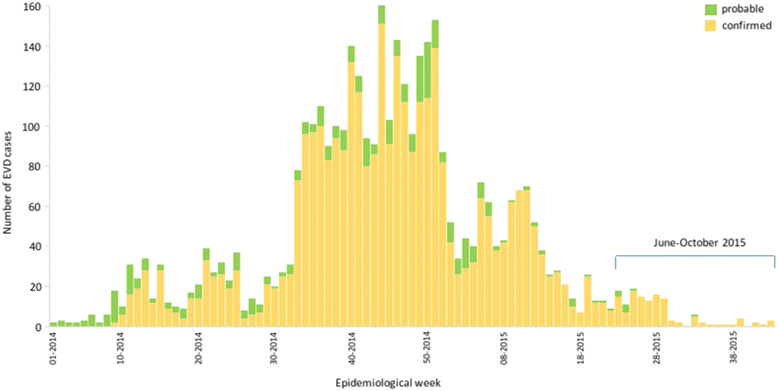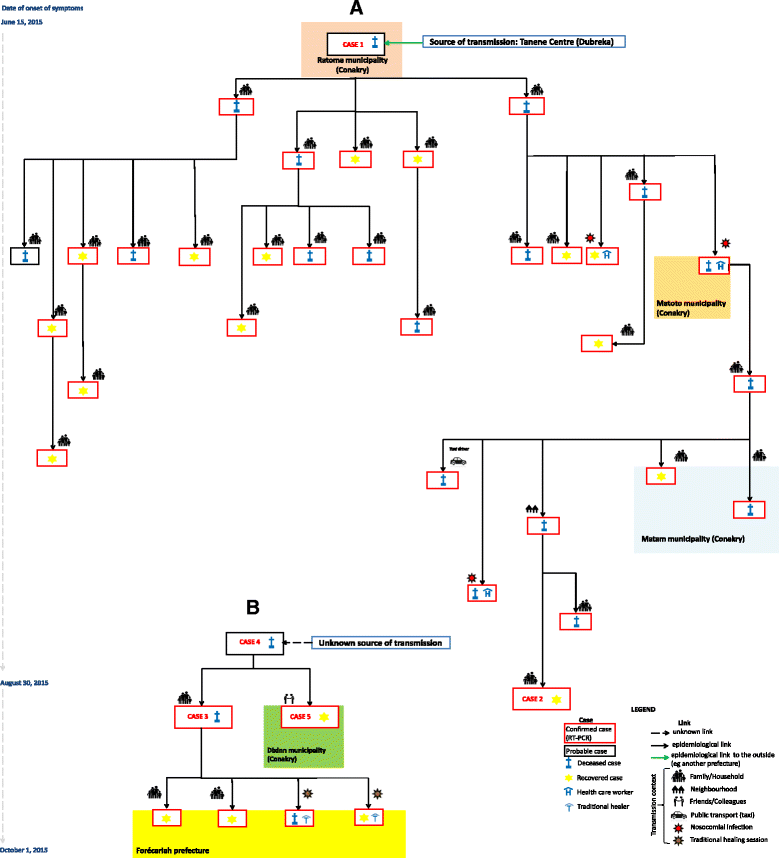Lessons learned by surveillance during the tail-end of the Ebola outbreak in Guinea, June-October 2015: a case series
- PMID: 28438127
- PMCID: PMC5404295
- DOI: 10.1186/s12879-017-2405-x
Lessons learned by surveillance during the tail-end of the Ebola outbreak in Guinea, June-October 2015: a case series
Abstract
Background: By the end of the 2013–2016 West African Ebola Virus Disease (EVD) outbreaks, a total of 3814 cases (probable and confirmed) and 2544 deaths were reported in Guinea. Clearly, surveillance activities aiming at stopping human-to-human transmission have been the breakthrough of EVD outbreak management, but their application has been at times easier said than done. This article presents five confirmed or probable EVD cases that arose in Conakry towards the end of the Guinea epidemic, which demonstrate flaws in surveillance and follow-up.
Case presentation: For case 1, safe burial requirements were not followed. For cases 1 and 2, negative Polymerase Chain Reaction (PCR) results were interpreted as no infection. For the first case, the sample may have not been taken properly while for the second the disease was possibly at its early stage. Case 3 was stopped at a border health checkpoint and despite her high temperature she was allowed to continue the bus journey. For case 4, an oral swab sample was supposedly taken after death but could not be found for retrospective testing. Despite characteristic symptomatology, case 5 was not identified as a suspect case for as long as 3 weeks.
Conclusion: In epidemic contexts, health systems must be able to track all samples of suspect cases and deaths, regardless of their laboratory results. Social mobilization in communities and training in health care facilities must be strengthened at the tail of an outbreak, to avoid the natural slackening of disease surveillance, in particular for long-lasting and deadly epidemics.
Background: By the end of the 2013–2016 West African Ebola Virus Disease (EVD) outbreaks, a total of 3814 cases (probable and confirmed) and 2544 deaths were reported in Guinea. Clearly, surveillance activities aiming at stopping human-to-human transmission have been the breakthrough of EVD outbreak management, but their application has been at times easier said than done. This article presents five confirmed or probable EVD cases that arose in Conakry towards the end of the Guinea epidemic, which demonstrate flaws in surveillance and follow-up.
Case presentation: For case 1, safe burial requirements were not followed. For cases 1 and 2, negative Polymerase Chain Reaction (PCR) results were interpreted as no infection. For the first case, the sample may have not been taken properly while for the second the disease was possibly at its early stage. Case 3 was stopped at a border health checkpoint and despite her high temperature she was allowed to continue the bus journey. For case 4, an oral swab sample was supposedly taken after death but could not be found for retrospective testing. Despite characteristic symptomatology, case 5 was not identified as a suspect case for as long as 3 weeks.
Conclusion: In epidemic contexts, health systems must be able to track all samples of suspect cases and deaths, regardless of their laboratory results. Social mobilization in communities and training in health care facilities must be strengthened at the tail of an outbreak, to avoid the natural slackening of disease surveillance, in particular for long-lasting and deadly epidemics.
Keywords: Case series; Contact tracing; Ebola; Epidemic; Guinea; Outbreak; Surveillance; Transmission.
Figures



References
-
- World Health Organization. Ebola situation reports: archive [Internet]. 2016 [cited 30 Jan 2017]. Available from: http://www.who.int/csr/disease/ebola/situation-reports/archive/en/
-
- World Health Organization. WHO Director-General addresses UN Security Council on Ebola. [Internet]. 2014 [cited 30 Jan 2017]. Available from: http://www.who.int/dg/speeches/2014/security-council-ebola/en/
-
- World Health Organization. Case definition recommendations for Ebola or Marburg Virus Diseases. [Internet]. 2014 [cited 30 Jan 2017]. Available from: http://www.who.int/csr/resources/publications/ebola/ebola-case-definitio...
-
- World Health Organization. WHO Strategic response plan. [Internet]. 2015 [cited 30 Jan 2017]. Available from: http://apps.who.int/iris/bitstream/10665/163360/1/9789241508698_eng.pdf?...
Publication types
MeSH terms
Substances
Grants and funding
LinkOut - more resources
Full Text Sources
Other Literature Sources
Medical

